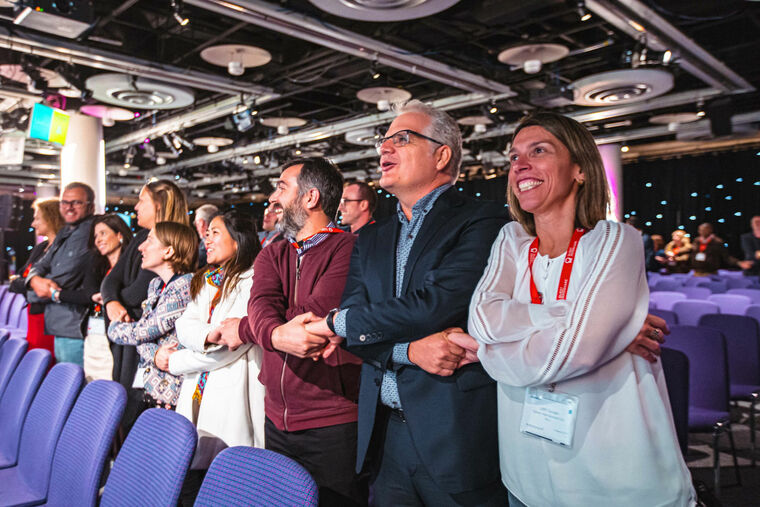Article series
Qualitative methods
- Safety and (dis)comfort in qualitative research
- Predictive qual
- Insight communities – hidden depths
- Brand ethics in pandemic time
- The hidden key to happiness
- Identity conflict
- Sales and market research
- Practising empathy
- Market research vs. UX research
- What do the futures of quant and qual methodologies hold?
- Social listening has a long way to go
- What I learned in my first 6 months as a market researcher
- Asking questions that will inspire more transformative insights
- Challenges of qualitative research today - Part 1
- Welcome to the Twatterverse!
- Challenges of qualitative research today - Part 2
- Best practices in writing a discussion guide
- Experience improvement
- The post-pandemic dominance of CRM and UX research
Product development and digital marketing in new and established companies have spurred the growth of digital user experience research, or UX research as we call it, in 2022.
UX research is nothing new. It had existed for a long time before the "UX" term became a thing - as part of the trend of adding an "X" to all things connected to the experience economy. Ironically, in the search for a unique identity, this research discipline is trying to grow apart from other adjacent research disciplines, including market research, from which UX research borrows heavily.
Current State
The current challenge with UX research is that most of its practitioners come from functions without a direct link to research, marketing, or business management.
Many UX researchers are first graphic designers, user interaction designers, or software developers who need to incorporate the customer or user perspective into their work by choice or mandate. Many UX practitioners operate under the mantra of "scrappy, fast, and dirty research," pressured by tight deadlines, small budgets, and DIY expectations that many tech companies have adopted as part of their agile product development model.
Why should market researchers /insights professionals care about this? Although many in the UX community have a negative opinion of marketing and market research, their methods are adaptations of market research techniques. Unfortunately, there is often a lack of rigour or connection to business outcomes.
Many market researchers who have been working long enough in the insights industry, know how low quality resulting from short deadlines, limited resources and lack of thinking time to translate insights into business implications, undermined the value of research at the C-suite level. UX research seems to be heading in the same direction.
What is UX?
UX stands for user experience.
The term user experience was first used in 1993 by the User Experience Department at Apple when they worked at improving the user experience of Apple computers. It is time to put to rest the myth that Steve Jobs was a research naysayer.
Don Norman, who was part of that group at Apple, and Jacob Nielsen co-founded the Nielsen Norman Group (NNg), a well-known consultancy and training agency that has advocated for best practices in UX research.
NNg’s founders defined user experience as a state of mind, combining emotions and attitudes resulting from user interactions with products and services, customer support, and even marketing.
However, over time, in reality, UX has become narrow in scope as a function in mostly digital-first and eCommerce companies to support software development, often disconnected from marketing and business strategy.
Customer Experience (CX)
In this context, a new crop of CX consultants and job titles has also come to add to the confusion.
Depending on the organisational structure and who does different types of research, the terms user experience and customer experience (CX) may be used interchangeably or kept separate to represent different teams.
CX is primarily grounded in customer satisfaction research, which has always been a market research discipline. Many in CX roles promote customer-centricity across all channels and use high-level metrics from customer satisfaction research like the NPS to connect customer-centricity to business impact.
While UX is often more concerned with micro-interactions with products and marketing channels, CX tries to get an integrated macro view of all interactions. Marketing is supposed to do that at a strategic level with the support of a mature and integrated market research function. This was precisely the role my research team played at Match.com and Blockbuster Online.
However, when marketing is disconnected from product development and gets reduced to short-term promotion tactics focusing on customer-facing channels without a strategic role, a vacuum is created for a new function trying to connect the dots to support strategic business outcomes.
Similar user experience drivers on- and off-screen
Developers of digital products like software, apps, and websites have been interested in the user experience at the micro-level, especially the usability aspect of the experience. For many years, the term "User Experience" has been used interchangeably with "Usability."
Usability contributes to the user experience but does not explain it thoroughly.
Usability aims at creating ease of use. Its technical definition includes ease of learning the task, becoming proficient, remembering how to perform it after stopping for a while, making few errors and recovering from them, and feeling satisfied with the experience.
Other contributing factors to the user experience are the surface design (visual/graphic design) and product functionality, which is the ability of the product to provide benefits and satisfy a need.
When we combine usability, utility, and surface design, we can have different user experiences depending on how we implement those dimensions. Ideally, we should develop products and services that meet a need, are easy to use, have a great surface design, and induce satisfaction.
These drivers of user experience are not exclusive to digital products. Traditional product market research uses qualitative and quantitative methodologies to understand similar drivers of the user experience in the physical world.
UX researchers and market researchers are essentially dealing with similar research questions even if the research techniques may require some adaptations to the medium in which the product lives.
Research function maturity
A 2019 study from usertesting.com about trends in the customer experience field found that many designers don't have access to research. Many researchers are struggling to do quality work at the rapid pace of product development. At the same time, an overwhelming majority of executives (86%) support scaling up user research.
The challenge usually lies in the level of UX maturity many companies have, which is strongly associated with the priorities for the business, management’s willingness to hire experienced researchers to build or manage research teams and provide them with resources to do research that moves the needle.
UX research maturity levels vary from product-focused companies with no research function to those with a research function that can handle tactical and strategic research to support the development of a product roadmap. Levels in the middle represent progressions in awareness, increased use of more advanced methodologies, and widening connections to other parts of the organisation.
The increased discussion about UX research maturity and the realisation that most digital companies are at a low maturity level has led to the call for a new research function: ResearchOps. This follows the trend of adding "Ops” (short for Operations) to everything that touches the product development process. The overarching goals of "ResearchOps" are to create standards for the research process and increase the involvement of internal stakeholders in it.
ResearchOps is essentially a new name for the old Market Research Group, although it doesn't reside in marketing and is more focused on data collection logistics such as in-house participant recruitment for qualitative research (e.g., user interviews and usability testing) and maintenance of data repositories, in any. Consequently, coordination of the UX research and market research/insights groups is rare even in more UX mature companies. Each group tends to work in a silo and hardly knows what the other is doing. Their research efforts are often not integrated or connected to common business goals.
As a market researcher, I often hear both curiosity about and dismissiveness of market research among UX practitioners, indicating some territorial hostility between both groups that prevent them from learning from each other.
The entrenched DIY approach in UX that has now extended to research operations to be faster and cheaper (up to a point) under the pressure of short deadlines in product development, lack of knowledge about the roots of the discipline exacerbated by terminology inflation, siloed structures, and lack of education standardization and pedagogy in this field are likely to delay maturity of the UX research discipline for some time.
Misconceptions about market research
Neither market researchers nor UX researchers realise they use similar research methods under different names.
Most UX researchers, which rely heavily on qualitative research methods for data collection, don't know that those techniques are adaptations of techniques market researchers have used for decades. The most common misconception of UX researchers is that market researchers only do quantitative research. Terminology inflation is usually part of the problem.
A typical example is the renaming of in-depth interviews (IDIs) based on the target audience (User interviews, stakeholder Interviews) or the interview's goals (Jobs-To-Be-Done Interviews for need exploration).
Personas research is another UX adaptation that comes from market segment profiling. Many UX practitioners don’t distinguish between market segmentation and personas, which is another name for a segment profile. Often, personas development is an internal opinion-based workshop exercise without actual market segmentation data behind it.
Currently, one can find LinkedIn posts advising UX practitioners to exclude demographic information from the description of personas. This indicates a lack of understanding of the impact demographics have on the context in which people use products and services. Ignoring this information can insert biases into product development due to a lack of diversity in the user experience.
The need for research integration
What is the problem with this separation between UX and market research?
Customers don't care about the channels. They will continue or stop buying from your brand based on cumulative experiences through multiple interactions in the stores, on the website, on the app, on customer service calls, or chat conversations.
Each interaction will affect brand perceptions, brand trust, and willingness to become or stay a customer. This is the result of an omnichannel experience.
To capture this omnichannel experience and become customer-centric, we need to both diversify and integrate research functions. We can achieve it by:
Building a diverse research team by age, gender, race, socio-economic background, culture, disability spectrum, and experience in UX research and market research/insights.
Combining qualitative and quantitative methods in market research and UX research projects deriving insights from triangulating different perspectives.
Using a hybrid model blending internal and external resources. Internal research teams are most efficient at supporting short-term and long-term business goals when they partner with external research suppliers for certain research tasks or projects. Relying only on DIY research may end up being more expensive and less efficient in a variety of scenarios.
These are not theoretical principles, but evidence-based best practices. I personally saw them in action during my time as a corporate researcher at Match.com and Blockbuster Online in the early 2000’s.
We had a small but integrated team that conducted qualitative and quantitative market research and UX research througha hybrid working model including internal DIY research and work supported by research suppliers. All research efforts were coordinated to reach key business outcomes, common to all businesses: adquire and retain customers to increase revenue, profits and cost on cost.
Final thoughts
Digital user experience is an exciting area of research that would benefit from the experience of market researchers. To support and better communicate with digital product teams, it helps to understand basic principles of interaction and graphic design, but researchers don't have to be designers or developers to conduct digital product research.
At the same time, designers, product managers, and developers who act as UX researchers should become familiar with the scientific method and qualitative and quantitative methodologies to guarantee a minimum level of quality and showcase its value to the organisation.
Diverse teams, integrated or working in coordination (“living apart together”) with a shared understanding of principles of research and different methodologies are more likely to have a bigger impact on business sustainability, enhance the value of research, and provide a rewarding research career for its members.
Michaela Mora
Founder at Relevant InsightsMichaela Mora, the founder of Relevant Insights, is an insights professional with a diverse background and more than 20 years of experience in market research, UX research, and multicultural research in many different industries. She is a graduate of the MSMR program at UTA and has working experience from both the client-side and the supplier-side in the U.S. and abroad, using qualitative and quantitative methodologies.
Before founding Relevant Insights in 2007, she managed the research team at Blockbuster Online, and Match.com after working as a researcher for MARC Research in Texas, Kantar in Sweden, and the Cuban Institute of Radio and Television in Cuba.
Michaela is also a founding member of the Multicultural Insights Collective, which conducts multicultural research into best practices to help brands speak both internally and externally on topics related to diversity, equity, and inclusion.
Article series
Qualitative methods
- Safety and (dis)comfort in qualitative research
- Predictive qual
- Insight communities – hidden depths
- Brand ethics in pandemic time
- The hidden key to happiness
- Identity conflict
- Sales and market research
- Practising empathy
- Market research vs. UX research
- What do the futures of quant and qual methodologies hold?
- Social listening has a long way to go
- What I learned in my first 6 months as a market researcher
- Asking questions that will inspire more transformative insights
- Challenges of qualitative research today - Part 1
- Welcome to the Twatterverse!
- Challenges of qualitative research today - Part 2
- Best practices in writing a discussion guide
- Experience improvement
- The post-pandemic dominance of CRM and UX research



